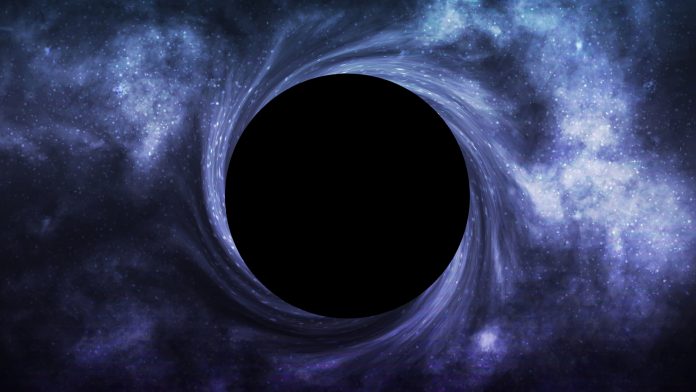What is a black hole – everything you need to know about black holes
Black holes have occupied the minds of scientists and even the general public for many years. These mysterious objects have a very strong gravity from which even light can not escape.
Black holes can be boldly considered one of the most mysterious and bizarre objects known; Especially with the recording of the first image of a black hole in 2019 and the confirmation of numerous hypotheses related to it, the interest of people and scientists in these objects increased; But what features make black holes so appealing and exciting?
What is a black hole?
According to a simple definition, a black hole is a point in space with a very high gravity and density from which even light can not escape. This gravity is so strong that it compresses all the materials in a small space. Albert Einstein first proposed the possibility of black holes in 1916 with the theory of general relativity. According to the theory of general relativity, a mass that is compressed enough can bend space-time to form a black hole. The irreversible boundary of the black hole was called the event horizon. Black holes do not reflect any light; But they can be identified by the effects they have on the materials and objects around them.
How is a hole list formed?
The most common way to form a black hole is to star death. Most stars swell and lose their mass as they reach the end of their lives, eventually turning into cold white dwarfs; But large stars that are ten to twenty times the mass of the Sun turn into neutron or black hole stars at the end of their lives.
When supermassive stars consume all of their core fuel, the star’s core becomes unstable and gravitationally infiltrates, eventually destroying the star’s outer layers. At the end of their lives, these stars explode in a massive explosion called a supernova, leaving behind black holes or neutron stars.
Stellar black holes
When the star runs out of fuel, it undergoes gravitational collapse. In smaller stars (three times the mass of the Sun), this process causes the new nucleus to turn into a neutron star or white dwarf; But with the collapse of larger stars, a black hole is formed.
Stellar black holes are usually very dense. These black holes place a mass three times the mass of the Sun in a space the diameter of a city. This creates a crazy gravitational pull. Stellar black holes can absorb gas and dust around them and become larger. The Milky Way has several million stellar black holes, according to the Harvard Smithsonian Institution of Astrophysics.
Large mass black holes
Large mass black holes, even though they are the same size as the Sun, are millions or billions of times heavier. Scientists believe these black holes are at the center of galaxies, including the Milky Way.
Scientists are still unsure how these black holes formed. Once formed, these giants absorb large amounts of matter, gas, and dust around them. The large amount of matter at the center of the galaxies made these objects very gigantic.
Large mass black holes may be the result of merging hundreds or thousands of small black holes. Large gas clouds may also collapse and absorb material rapidly. The third option for the formation of these black holes could be the collapse of stellar clusters and the fourth option could be the formation of large mass black holes from large clusters of dark matter. This substance can be detected by gravitational effects on other objects, however, scientists still do not know the nature and elements that make it up because it does not emit light and can not be directly observed.
Simulation of large mass black holes. Jordi Diular and his colleagues used virtual reality to simulate black holes. In this simulation, a black hole is surrounded by glowing material. The material disappears in a vortex-like manner in the black hole, producing a glowing plasma. The light is then distorted by the strong gravity of the black hole.
Medium mass black holes
Scientists once thought that black holes could be divided into large and small spectra; But new research shows that there are also medium mass black holes, or IMBHs. These objects may have been formed by the collision of clusters of stars. A number of IMBHs that form in an area eventually join together at the center of the galaxy to form large mass black holes. In 2014, astronomers found medium-mass black holes in the arm of a spiral galaxy. According to Tim Robertt from Durham University in the UK:
Astronomers were working hard to discover these medium-sized black holes. There were signs of them; But these black holes were not interested in being discovered.
According to research in 2018, there may be medium-mass black holes at the heart of dwarf galaxies (very small galaxies). Observations of ten of these galaxies (five of which were unknown before this study) showed that conventional X-ray activity in black holes could be evidence of the existence of black holes with 36,000 to 316,000 solar masses. This information came from the Sloan Digital Sky study, which examines one million galaxies.
Early black holes
The hypothesis of a non-stellar black hole was also proposed by the British physicist Stephen Hawking . According to Hawking’s theory, primordial small black holes are the same mass or smaller than an asteroid that may have formed during the Big Bang. Big Bang is a state of high density and temperature from which the universe began about 13.8 billion years ago. These black holes are also called micro-black holes, which, like more massive black holes, lose their
mass over time through Hawking radiation and disappear. If theories of the universe with more dimensions are correct, the Large Particle Accelerator can produce a number of micro-black holes.
Types of black holes in terms of rotation and charge
According to astronomical theories, if a black hole has an orbital motion, space pulls time around its event horizon. This rotation of space around the event horizon is called a function, which is elliptical. In the case of objects, they can not fall into the black hole because the sphere is outside the event horizon. Also, black holes are divided into two categories in terms of electric charge, with and without charge, and in terms of angular momentum, which determines the rotation of the black hole, into two categories, rotating and non-rotating. The rotating black holes correspond to the Einstein field equation.
What is inside the black holes?
Black holes have three layers: external and internal event horizons and singularity.Event Horizon: The black hole event horizon is the boundary around the black hole aperture from which even light cannot escape. Once a particle crosses the event horizon, it can no longer exit the black hole. Gravity is fixed on the event horizon. The black hole event horizon is directly related to the object’s escape velocity.
The escape velocity is the velocity required to escape the gravitational pull of a black hole. The closer one gets to the black hole, the faster it needs to escape its massive gravitational pull. On the event horizon, the escape velocity exceeds the speed of light.
According to Einstein’s theory of general relativity, nothing moves faster in space than light. As a result, the event horizon is called the point of no return. As the object approaches the event horizon, a hypothetical witness can see the image disappear. This blurring is caused by the bending of light by gravity. On the event horizon, the image of the object moves towards invisibility.
Singularity: The inner part of a black hole that defines its mass is called singularity. A single point in space and time where the mass of a black hole condenses. The texture of space-time bends infinitely around the singularity, thus violating the physical laws we know at this point.
Scientists cannot observe black holes like stars and other space objects; Rather, their observations depend on the detection of emitted rays from black holes as well as the gas and dust around them; But large mass black holes at the center of the galaxy are usually surrounded by thick clouds of gas and dust that make it difficult to observe other rays.
Other components of the black hole
Accumulation disk: Most black holes are surrounded by very hot disks of matter, much of which are made up of gas and dust from other objects such as stars and planets. These materials fall into the black hole. These hot, turbulent disks are called “growth pills.”
Black hole shadow: A black hole shadow is a dark, two-dimensional region in the celestial sphere that is formed by the strong gravity of a black hole. There are a series of photon paths in this area that could not escape the black hole and were trapped.
Photonic sphere: In a photonic sphere, gravity is so strong that light can travel in circular paths.
Relative Jet: Sometimes matter after entering a black hole, it bounces off the event horizon and is ejected outwards. Under these conditions, bright jets of matter are formed that move at speeds close to the speed of light. Although black holes appear invisible, these powerful jets can be observed from a distance.
Evaporation of black holes and Hawking radiation
Hawking radiation is a beam that is emitted near the horizon of a black hole event due to quantum effects. These rays indicate that the temperature of black holes is proportional to their mass. Hawking radiation, although not yet observed, has strong scientific support for the combined models of general relativity and quantum mechanics. The phenomenon is named after the physicist Stephen Hawking, who published an article in 1974 entitled Black Hole Explosions. The Hawking radiation hypothesis means that black holes can emit energy and thus become smaller in size.
Whenever matter enters a black hole, it cannot leave it again. This phenomenon can eliminate the scale of disorder or entropy. Since the removal of matter reduces irregularity, the black hole was thought to violate the second law of thermodynamics. The physical process of Hawking radiation and the propagation of particles from near the black hole event horizon is very complex and requires an integrated understanding of mathematics and quantum theories.
According to Hawking’s theory, the area of black holes increases over time.
But recently, Hawking’s famous theory of the entropy of black holes has been substantiated and many ambiguities have been dispelled. Stephen Hawking proposed the theory of the area of a black hole in 1971 based on Einstein’s theory of general relativity. According to this theory, it is impossible for the surface area of a black hole to decrease over time. This theory was proved by observing the merger of two black holes and the gravitational waves resulting from this merger. Based on this assumption, the area of a black hole resulting from the merger of two black holes increases.
Many believe that Hawking’s law of area contradicts his other theory, the evaporation of black holes. On the other hand, according to the theory of general relativity, black holes cannot shrink, while according to quantum mechanics, they can. In Hawking’s theory of radiation, fog of particles is emitted due to the quantum effects of the edges of black holes, and this phenomenon eventually leads to the shrinkage of the black hole and eventually its evaporation over longer periods of the universe. Since this evaporation occurs in the long run, it can be said that it does not violate the law of area in the short run. In any case, there is still a lot of speculation about black holes; But the theory of area so far conforms to the second law of thermodynamics.



